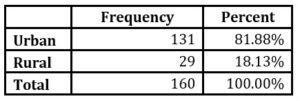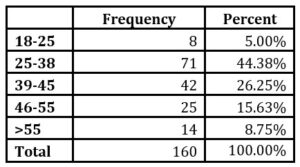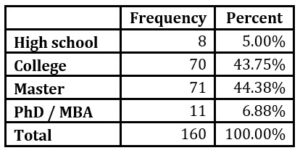Introduction
Burnout, also known as depressive anxiety syndrome, is considered to be a psychological state that manifests itself through chronic fatigue, fatigue that manifests itself even at the idea of work, physical problems and restless sleep. Maslach, C., Schaufeli, W.B. & Leiter, M. P. (2001, 397) consider the burnout to be a prolonged response to chronic stress factors, both emotional and interpersonal, that intervenes in the workplace. Halbesleben, J. & Buckley, M. (2004,866) considers, based on previous studies, that burnout can lead to negative effects, both for employees and for the organization, finding that, in addition to the psychological symptoms that employees are re-establishing, this phenomenon negatively influences certain job attitudes (such as engagement and satisfaction), while also leading to increased desire to leave the current job.
Maslach, C. and Leiter M. P. (2016, 105) considered that there were six factors that could lead to burnout. These are: workload (that can leads to lack of the ability of the employees to fulfill the requirements of the job), control (burnout is generally showing up when employees feel they have no possibility to influence the work-related decisions), rewards (when they are insufficient and when there is no recognition), the community (referring to the lack of support on which relations between colleagues are characterized), fairness (equity and social justice) and values (when the personal values that initially attracted the employee to the current job begin to diverge from the organizational ones). The effects of burnout are considered to be job dissatisfaction, low organizational commitment, absenteeism, intention to leave the job, and turnover (Maslach, C. & Leiter, M. P., 2016, 105).
Crawford, E.A. & Jeffery A. LePine, J.A. (2010,836) identified the relationship between the burnout and job demand, namely that a constant increase in an employee’s efforts to meet the job demand gradually leads to her/him being drained of energy, both physical and mental, the employee feeling, over time, that it is used and worn out.
Maslach, C., Jackson, S. E. & Leiter, M. P. (1996,194) considered burnout as a psychological state, which manifests itself through emotional exhaustion (employees feel drained of emotional resources, experiencing the feeling that they can no longer devote themselves to work), depersonalization (employees have negative attitudes, cynical dreams of work) and a feeling of low personal fulfillment (employees feel dissatisfied with their own person, as well as in relation to the results of their work). The tool developed by the authors for measuring burnout was Maslach Burnout Inventory, used to evaluate the three psychological states that characterize this syndrome. Maslach Burnout Inventory has 22 elements, divided into three subscales and presented in the form of statements regarding personal attitudes or feelings. The emotional exhaustion subscale contains nine elements and that of depersonalization five. Since the elements on these two subscales measure emotional exhaustion and, respectively, the lack of sensitivity and the depersonalized responses in relation to work, the results with high values on these two subscales prove a high level of burnout. It should also be noted that these two subscales are considered by the authors to present certain moderate correlations between them, which is consistent with the theoretical findings that the two components, although, separate, constitutes associated aspects of burnout. The subscale relating to personal fulfillment, consisting of eight elements, is considered to be independent, having only a reduced correlation with the other two. Unlike the first two scales, the results of small values on this scale are specific to a high level of burnout, because the components are used to measure feelings of competence and achievement. Halbesleben, J. R.B. & Demerouti, E. (2005, 209) even show that certain authors consecrate to be more suited to a model based only on Emotional Exhaustion and Depersonalization, especially because of less strong relationships that are established between Personal Accomplishment and organizational results, while Emotional Exhaustion and Depersonalization present strong relationships with them.
Research outline
Research objectives
Even if burnout syndrome is a very common topic in the academic literature and in the studies conducted by practitioners, in Romania very little research has been undertaken on this topic (especially among medical staff). The primary objective of this paper was to identify the burnout level of the employees from Romanian companies. Maslach Burnout Inventory was used and its three components were analyzed: Emotional Exhaustion, Depersonalization and Personal Achievement. The second objective of the paper was to identify the burnout level of the employees from Romanian companies based on demographic characteristics.
Research hypotheses
The following hypotheses were the basis of the study that we undertook:
- H1: the burnout level of employees from Romanian companies is high
- H2: the number of female individuals experiencing a high burnout level is higher than the male number
- H3: the highest percentage of people experiencing high burnout levels is registered among people with a high level of education
- H4: the highest percentage of people experiencing high burnout levels is registered among people with a higher level of professional experience
Methodology
The research was carried out using a questionnaire developed in Google Forms and uploaded to Facebook within groups with specific themes in Romania (accounting and tax consulting, HR and labor legislation, legal, entrepreneurship). This method was adopted in view of the social distance requirements imposed by the COVID-19 pandemic. Although critical from the point of view of the possibility of building a representative sample of the employed population in Romania, we consider this way of distributing the questionnaire as compliant in terms of respecting the conditions for obtaining relevant results, namely respect for privacy (respondents are not influenced by other people’s answers) and respect for confidentiality (respondents must be convinced that they can express their real feelings) (Maslach , C., Jackson, S.E., & Leiter, M. P. (1996, 195).
Maslach Burnout Inventory was used with 22 questions: nine questions for The Emotional Exhaustion scale, five questions for Depersonalization scales and eight questions for Personal Achievement scales. As a way of answering a Likert scale in 7 steps was used. We adopted the 7-step scale (based on intensity) because Worley, J.A., Vassar, M., Wheeler, D. L. & Barnes, L. L.B. (2008, 798-799) found that most studies based their research on a 5-trap scale (frequency).
Population
The population of this study is composed of 160 people.
The respondents were both male and female and the gender frequency is shown in the table below.
Table 1: Gender of the respondents
The population repartition by area of residence is shown in Table 2.
Table 2: Area of residence of the respondents
The response for this article were given by respondents with different ages and a large variety of seniority level, as shown in Table 3 and Table 4.
Table 3: Age of the respondents

Table 4: Seniority level of the respondents

It is important to be mentioned that both for age and seniority level the largest amount of data were collected for the most active categories on the labor market at this moment.
We considered the respondent’s educational level as being important for the relevance of this studies. The categories of educational level and the repartition for each category are shown in Table 5. It should be mentioned that the survey included primary school and gymnasium as the last form of education completed, but no answer was received for these categories.
Table 5: Educational level of the respondents

Findings
Emotional Exhaustion
Halbesleben, J. R. B. & Demerouti, E. (2005,208) considered that Emotional Exhaustion refers to feelings of being overextended and depleted of one’s emotional and physical resources. Ducharme, L. J., Krudsen, H. K. & Roman, P.M. (2008.82) identified that the emergence of Emotional Exhaustion is significantly influenced by the lack of autonomy and lack of distributive justice within the organization, while the support felt by colleagues can lead to its reduction. Also, referring to the professions practiced, the authors find that there are professions, such as counseling, in which, although the human relationship is less frequent, the emotional investment in the human relationship is very intense (Ducharme, L. J., Krudsen, H. K. & Roman, P.M., 2008, 82). Maslach, C. &Leiter M. P. (2016, 103) also found that for many years the phenomenon of burnout was considered as a phenomenon of an occupational nature, oriented towards people-oriented trades, such as human resources, health and education. Bakker, A.B., Demerouti, E. & Sanz-Vergel, A.I. (2014, 390) found that over time this idea was dropped out and the specialists conceptualized the burnout so that it could become applicable to all fields of activity.
The results obtained after processing the data collected are shown in the tables shown below:
Table 6: Emotional Exhaustion by Gender of the respondents

Table 7: Emotional Exhaustion by Age of the respondents

Table 8: Emotional Exhaustion by Seniority level of the respondents

Table 9: Emotional Exhaustion by Educational level of the respondents

The conclusion is that a large number of employees from the population of the research show a high level of Emotional Exhaustion (28,75%). Also, we consider as being very alarming the significant level of employees which resent a medium level of Emotional Exhaustion (62,50%). These employees can in any moment stat to experience a high level of Emotional Exhaustion if the organizations will not take urgent measures in order to reduce stress factor.
The category which experience the most Emotional Exhaustion is: female/master studies/age between 25-38 years/10-15 years of professional experience.
Depersonalization
Halbesleben, J. R. B., & Demerouti, E. (2005,208) showed that Depersonalization refers to a negative, callous, or excessively detached response to various aspects of the job, response that can be either exacerbated or excessively detached.
The results obtained after processing the data collected are shown in the tables shown below:
Table 10: Depersonalization by Gender of the respondents

Table 11: Depersonalization by Age of the respondents

Table 12: Depersonalization by Seniority level of the respondents

Table 13: Depersonalization by Educational level of the respondents

The study reveals a small amount of employees which presents a high level of Depersonalization (6,25%). Instead, the number of employees experiencing a medium level of Depersonalization is very large (71,88%). We consider that the reason for which a part of the employees experience a medium and not a high level of Depersonalization is due generally to personal factors (generally in Romanian organizations employees used to adopt more friendly and human relationships during working hours).
The category which experience the most Depersonalization is: female/college studies/age between 39-45 years/15-25 years of professional experience.
Personal Accomplishment
Maslach, C., Schaufeli, W.B. & Leiter, M. P. (2001, 399) believes that Personal Accomplishment is manifested by feelings of lack of personal achievement, lack of competence and lack of productivity.
Table 14: Personal Accomplishment by Gender of the respondents

Table 15: Personal Accomplishment by Age of the respondents

Table 16: Personal Accomplishment by Seniority level of the respondents

Table 17: Personal Accomplishment by Educational level of the respondents

Our analysis shows that there is only a small number of employees which resent a high level of Personal Accomplishment (0,63%). The rest resent a low level (46,25%) or a medium level (53,13%) of Personal Accomplishment. The conclusion is that the largest number of employees resent a lack of achievement and a misfit with their current job.
Conclusions
The results of the study reveal the fact that the biggest number of employees resent a medium level of burnout (63,13%).
The results are consistent with the conclusion of other studies and confirm that Emotional Exhaustion is the most important component of burnout.
Regarding the validity of research hypotheses, we can conclude the following:
- Research hypothesis no. 1 has not been confirmed, the research demonstrating that the majority of employees of organizations in Romania feel an average burnout level, in the light of the analysis of all three of its components, and not a high level, as the hypothesis assumed
- Hypothesis No. 2 has been fully validated. From an Emotional Exhaustion perspective, 31.45% of female persons have a high level, compared to 19.44% manifested by male persons. From Depersonalization perspective, 7.26% of female persons have a high level, compared to 2.78% manifested by male persons. From a Personal Achievement perspective, the results were inconclusive, with high values of Personal Achievement recorded on a very small number of respondents, both female and male. Given that Emotional Exhaustion is the most important component of burnout, and in this component female persons have registered a significantly higher percentage, we can consider the hypothesis to be validated.
- Hypothesis No. 3 has been confirmed. From the perspective of those with a high level of Emotional Exhaustion, 33.33% were Master graduates, but only 1.41% of them also showed a high level of Personal Accomplishment. From Depersonalization perspective, high levels were determined in 10% of college graduates. Considering that Emotional Exhaustion is the most important component of burnout, and in the case of this component 33.33% (i.e. the highest percentage) was registered by Master graduates, we can consider the hypothesis to be validated.
- Hypothesis No. 4 has not been validated. The highest burnout level was determined among people with an average level of professional experience, of 10-15 years.
Limitations
The way of distributing the questionnaire in order to collect the answers did not allow us to carry out a sample that is representative of the entire population of Romania. Thus, one can notice the very small number of male employees who answered the questionnaire, which is why a comparison between female and male employees in terms of burnout level is limited. The answers were provided only by people with at least high school, which did not allow us to measure the burnout level of people with primary and secondary education. Also, being published in groups with a certain specificity, we consider that it was not possible to measure the burnout level for all categories of employees in Romania. Another limitation we consider to be the small number of respondents.
Acknowledgment
There was no external funding.
References
- Bakker, A.B., Demerouti, E. & Sanz-Vergel, A.I. (2014) ‘Burnout and Work Engagement: The JD–R Approach’, The Annual Review of Organizational Psychology and Organizational Behavior, [Online], [Retrieved April 30, 2021], orgpsych.annualreviews.org, 389-411.
- Crawford, E.A. & Jeffery A. LePine, J.A. (2010) ‘Linking Job Demands and Resources to Employee Engagement and Burnout: A Theoretical Extension and Meta-Analytic Test’, Journal of Applied Psychology, 95(5), 834–848.
- Ducharme, L. J., Knudsen, H. K. & Roman, P. M. (2008). ‘Emotional exhaustion and turnover intention in human service occupations:the protective role of coworker support’, Sociological Spectrum, 28, 81-104.
- Halbesleben, J. & Buckley, M. (2004). ‘Burnout in organizational life’, Journal of Management, 30, 859–879.
- Halbesleben, J. R. B. & Demerouti, E. (2005) ‘The construct validity of an alternative measure of burnout: Investigating the English translation of the Oldenburg Burnout Inventory’, Work and Stress, 19, 208-220.
- Maslach, C., Jackson, S. E. & Leiter, M. P. (1996) Maslach Burnout Inventory Manual (3rd ), Consulting Psychologists Press, Palo Alto, CA.
- Maslach, C., Schaufeli, W. B. & Leiter, M. P. (2001) ‘Job burnout’, Annual Review of Psychology, 52, 397-422.
- Maslach, C. & Leiter M. P (2016) ‘Understanding the burnout experience: recent research and its implications for psychiatry’, World Psychiatry, 15(2), 103-111.
- Worley, J.A., Vassar, M., Wheeler, D. L. & Barnes, L. L. B. (2008) ‘Factor Structure of Scores From the Maslach Burnout Inventory: A Review and Meta-Analysis of 45 Exploratory and Confirmatory Factor-Analytic Studies’, Educational and Psychological Measurement , 68, 797-822.




















